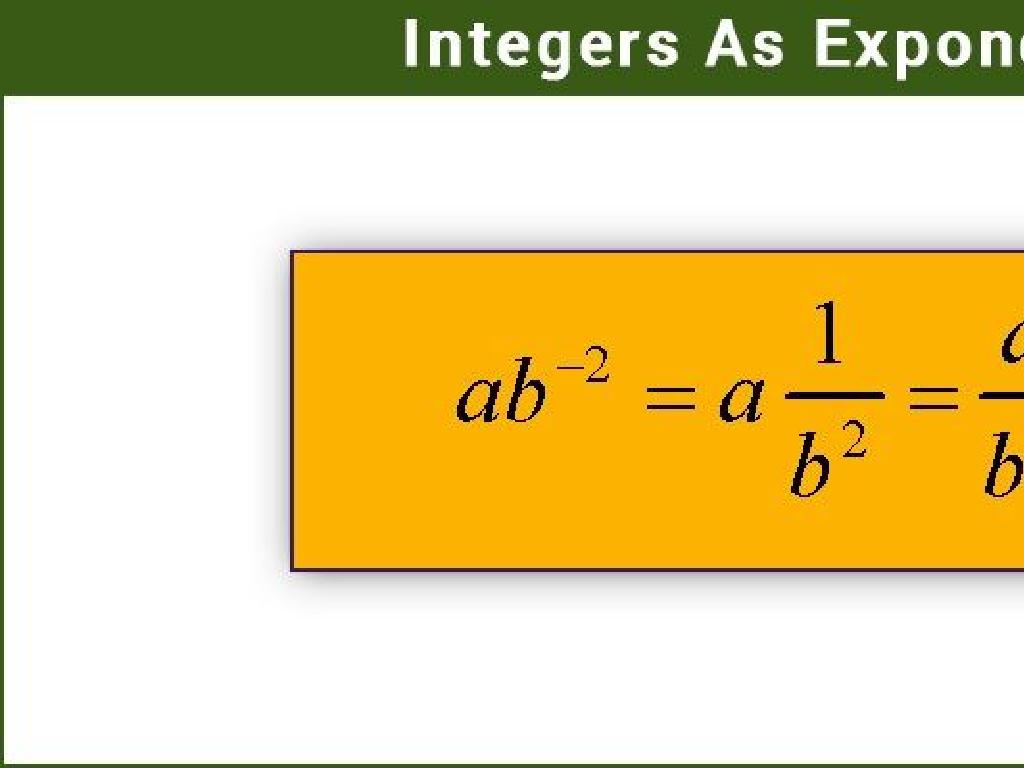To Have: Use The Correct Form
Subject: Language arts
Grade: Third grade
Topic: Verb Tense
Please LOG IN to download the presentation. Access is available to registered users only.
View More Content
Getting to Know Verb Tenses
– What are verb tenses?
Verb tenses tell us when an action happens.
– The meaning of ‘tense’
Tense is the grammar term for time.
– Today’s special verb: ‘to have’
‘To have’ shows possession or existence.
– Practice using ‘to have’
We’ll use ‘to have’ in past, present, and future.
|
This slide introduces the concept of verb tenses to third-grade students, focusing on the verb ‘to have’. Begin by explaining that verb tenses help us understand when something happens whether it’s in the past, present, or future. Clarify the term ‘tense’ as it relates to time in grammar. Highlight the importance of the verb ‘to have’, which is used to show possession or existence. Engage the students with examples and practice sentences to illustrate the use of ‘to have’ in different tenses. Encourage students to think of their own examples and be ready to share them. This will set a foundation for understanding how verbs change according to the time of the action.
Understanding Verbs: Action Words!
– Verbs show action or state
– Verbs tell us what’s happening
– Examples: run, jump, is, have
– Actions like ‘run’, states like ‘is’, possession like ‘have’
– ‘To have’ in different tenses
– Past: had, Present: have/has, Future: will have
|
This slide introduces the concept of verbs to third-grade students, emphasizing that verbs are words that express action or a state of being. It’s crucial to provide clear examples that students can relate to, such as ‘run’ for action and ‘is’ for a state of being. Highlight the verb ‘to have’ as it’s used to show possession and can change form depending on the tense. Explain that ‘had’ is used for the past, ‘have’ or ‘has’ for the present, and ‘will have’ for the future. Engage the students with examples they can act out or relate to their daily experiences to reinforce learning.
Mastering the Verb ‘To Have’
– ‘To have’ shows possession
– Used in different ways
– Not just for possession, but also experiences
– Examples: ‘I have a book’
– It’s mine because I have it!
– Practice: ‘You have eaten?’
– Change to ‘Have you eaten?’ to ask someone
|
This slide introduces the verb ‘to have’ to the third-grade students, emphasizing its primary function to indicate possession. It’s crucial to highlight that ‘to have’ can also be used to talk about experiences or actions that have been completed, as in perfect tenses. Provide clear examples to illustrate possession, such as ‘I have a book,’ which shows that the book belongs to the speaker. Then, demonstrate its use in questions about experiences, correcting ‘You have eaten?’ to the proper form ‘Have you eaten?’ Encourage students to come up with their own sentences using ‘to have’ to describe possession and experiences. Practice with the class by asking them to find things they have and share with the class, as well as discussing activities they have done recently.
Present Tense – ‘To Have’
– Use ‘have’ with I, you, we, they
– Use ‘has’ with he, she, it
– ‘I have a pet dog’ example
– Shows possession of a pet dog
– ‘She has a pet cat’ example
– Indicates she owns a pet cat
|
This slide introduces the present tense forms of the verb ‘to have’. It’s important to explain that ‘have’ and ‘has’ are used to show possession and are determined by the subject. Use ‘have’ when the subject is I, you, we, or they. Use ‘has’ when the subject is he, she, or it. Provide examples to illustrate the use of ‘have’ and ‘has’ in sentences. Encourage students to create their own sentences using both ‘have’ and ‘has’ with different subjects to practice and reinforce their understanding of the concept.
Past Tense – ‘To Have’
– ‘Had’ is used for past tense
– Example: ‘I had a great time.’
– Shows something happened before now
– Practice sentence completion
– Fill in with ‘had’: ‘We ___ a party last week.’
– Understand past tense usage
– Recognize when to use ‘had’ in sentences
|
This slide introduces the past tense form of the verb ‘to have’. Emphasize that ‘had’ is used for all subjects (I, you, he, she, it, we, they) in the past tense. Provide the example ‘I had a great time.’ to illustrate a completed action in the past. For practice, ask students to complete the sentence ‘We ___ a party last week.’ with ‘had’. This exercise helps students understand the concept of past tense and reinforces the correct use of ‘had’. Encourage students to think of their own examples and share them with the class to ensure comprehension.
Future Tense with ‘To Have’
– ‘Will have’ for future events
– Example: Piano lesson tomorrow
– ‘I will have a piano lesson tomorrow.’
– Let’s predict with ‘will have’
– Use ‘will have’ to talk about future
– Fill in the blank exercise
– ‘Next year, I ___ a new bicycle.’
|
This slide introduces the future tense form of the verb ‘to have.’ Students will learn that ‘will have’ is used to talk about something they will possess or experience in the future. Start with the example provided to illustrate how ‘will have’ is used in a sentence. Then, engage the students with a fill-in-the-blank exercise to apply what they’ve learned. Encourage them to think about things they might have in the future and use ‘will have’ to describe it. This exercise helps to reinforce their understanding of future tense and the use of ‘to have.’
Using ‘To Have’ in Sentences
– ‘To have’ in present tense
– I have a pet dog. She has a red ball.
– ‘To have’ in past tense
– Yesterday, I had a sandwich. He had a great time at the park.
– ‘To have’ in future tense
– Tomorrow, I will have a new book. She will have a piano lesson.
– Making sentences together
|
This slide is designed to help students understand how to use the verb ‘to have’ in different tenses. Start by explaining that ‘to have’ can show possession or existence of something. Then, demonstrate how ‘to have’ is used in the present, past, and future tenses with examples. Encourage students to create their own sentences by giving them a subject and asking them to use ‘to have’ in various tenses. This activity will reinforce their understanding of verb tenses and how they are used in everyday language. Make sure to provide feedback and guidance as they craft their sentences.
Class Activity: Mastering ‘To Have’ in All Tenses
– Collaborative story creation
– Each student adds a sentence
– Focus on ‘to have’ in various tenses
– Past: ‘had’, Present: ‘have/has’, Future: ‘will have’
– Ensure correct verb tense usage
|
This activity is designed to help students practice the verb ‘to have’ in different tenses through a fun and interactive storytelling exercise. Each student will contribute to a class story by adding one sentence, ensuring they use the correct form of ‘to have’. It’s important to guide them through past, present, and future tenses, demonstrating how the verb changes. For example, past tense: ‘Yesterday, I had a big sandwich for lunch.’ Present tense: ‘I have a pet turtle named Tim.’ Future tense: ‘Tomorrow, we will have a quiz in math.’ Encourage creativity and correct usage, and make sure to correct any mistakes gently and explain the proper form.
Review and Practice: Using ‘To Have’
– Review ‘to have’ usage
– ‘To have’ shows possession or existence
– Practice with a worksheet
– Complete sentences using ‘has’ or ‘have’
– Fill in the blanks
– Choose the correct form to complete sentences
– Share your answers
|
This slide is aimed at reinforcing the students’ understanding of the verb ‘to have’ and its correct usage in sentences. Begin by reviewing the concept that ‘to have’ indicates possession or existence. Distribute worksheets with sentences that have missing ‘to have’ verbs and ask the students to fill in the blanks with either ‘has’ or ‘have’. Encourage them to think about the subject of the sentence to determine the correct form. After completing the worksheet, students should be given the opportunity to share their answers with the class or in small groups to foster collaborative learning and peer feedback. The teacher should circulate the room, offering guidance and correcting misconceptions as needed.
Wrapping Up: ‘To Have’ Verb Forms
– Congratulations on learning ‘to have’!
– Homework: Complete the ‘To Have’ worksheet
– Worksheet helps practice different forms of ‘to have’
– Bring questions to the next class
– We’ll review any uncertainties in our next meeting
– Practice makes perfect!
|
This slide concludes the lesson on the verb ‘to have’ and its correct usage in various tenses. The homework assignment is designed to reinforce the day’s learning by providing students with a worksheet that they should complete at home. The worksheet will have exercises on the present, past, and future forms of ‘to have.’ Encourage students to attempt all questions and remind them that making mistakes is a part of learning. Let them know that they can bring up any questions or difficulties they encounter while completing the worksheet in the next class. This will help ensure that they have understood the lesson and provide an opportunity for clarification.





